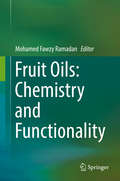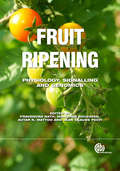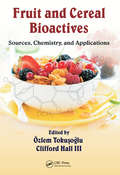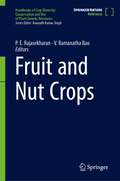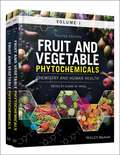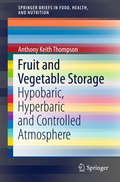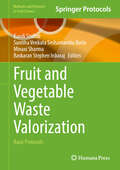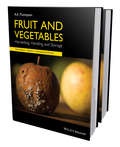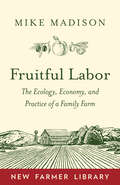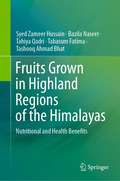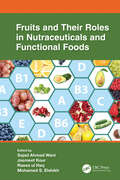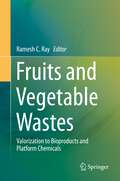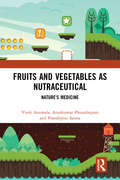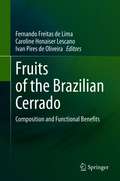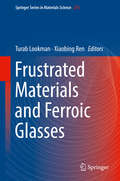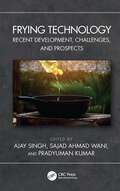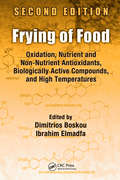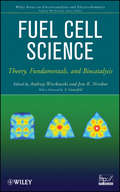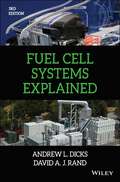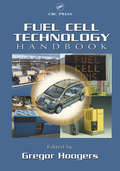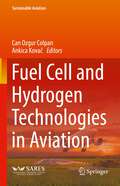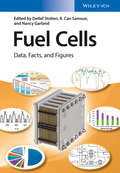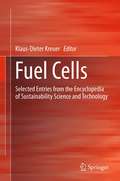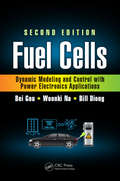- Table View
- List View
Fruit Oils: Chemistry and Functionality
by Mohamed Fawzy RamadanFruit Oils: Chemistry and Functionality presents a comprehensive overview of recent advances in the chemistry and functionality of lipid bioactive phytochemicals found in fruit oils. The chapters in this text examine the composition, physicochemical characteristics and organoleptic attributes of each of the major fruit oils. The nutritional quality, oxidative stability, and potential food and non-foodapplications of these oils are also extensively covered. The potential health benefits of the bioactive lipids found in these fruit oils are also a focus of this text. For each oil presented, the levels of omega-9, omega-6 and omega-3 fatty acids are specified, indicating the level of health-promoting traits exhibited in each. The oils and fats extracted from fruits generally differ from one another both in terms of their major and minor bioactive constituents. The methods used to extract oils and fats as well as the processing techniques such as refining, bleaching and deodorization affect their major and minor constituents. In addition, different post-processing treatments of fruit oils and fats may alert or degrade important bioactive constituents. Treatments such as heating, frying, cooking and storage and major constituents such as sterols and tocols are extensively covered in this text. Although there have been reference works published on the composition and biological properties of lipids from oilseeds, there is currently no book focused on the composition and functionality of fruit oils. Fruit Oils: Chemistry and Functionality aims to fill this gap for researchers, presenting a detailed overview of the chemical makeup and functionality of all the important fruit oils.
Fruit Ripening
by Christopher Davies Véronique Cheynier Autar K. Mattoo Autar Handa Don Grierson Asaph Aharoni Angelos Kannellis Cornelius Barry Mathilde Causse Arun Sharma Hiroshi Ezura Mondher Bouzayen Alisdair Fernie Jean Claude Pech Kunsog Chen Pravendra Nath Abhay Dandekar Joseph Hirschberg Mark Tucker Kailash Bansal Jim Giovannoni Christophe Rothan Giovanni GiulianoFruit ripening is an important aspect of fruit production. The timing of it affects supply chains and buying behaviour, and for consumers ripeness not only affects perceptions of health but has nutritional effects too. Ripeness is closely related to spoilage which has a major financial impact on agricultural industries. Currently there are fast moving developments in knowledge of the factors affecting fruit ripeness, and this up-to-date monograph seeks to draw together the disparate research in this area. The aim of the book is to produce a comprehensive account covering almost every area related to fruit ripening including the latest molecular mechanisms regulating fruit ripening, its impact on human nutrition and emerging research and technologies.
Fruit Ripening: Physiology, Signalling and Genomics
by Christopher Davies Véronique Cheynier Autar Handa Don Grierson Asaph Aharoni Angelos Kannellis Cornelius Barry Mathilde Causse Arun Sharma Hiroshi Ezura Alisdair Fernie Kunsog Chen Joseph Hirschberg Mark Tucker Kailash Bansal Jim Giovannoni Christophe Rothan Giovanni Giuliano Abhaya DandekarFruit ripening is an important aspect of fruit production. The timing of it affects supply chains and buying behaviour, and for consumers ripeness not only affects perceptions of health but has nutritional effects too. Ripeness is closely related to spoilage which has a major financial impact on agricultural industries. Currently there are fast moving developments in knowledge of the factors affecting fruit ripeness, and this up-to-date monograph seeks to draw together the disparate research in this area. The aim of the book is to produce a comprehensive account covering almost every area related to fruit ripening including the latest molecular mechanisms regulating fruit ripening, its impact on human nutrition and emerging research and technologies.
Fruit and Cereal Bioactives: Sources, Chemistry, and Applications
by Özlem Tokuşoğlu Clifford Hall IIIPresenting up-to-date data in an easy-to-use format, this comprehensive overview of the chemistry of bioactive components of fruits and cereals addresses the role of these compounds in determining taste, flavor, and color, as well as recent claims of anticarcinogenic, antimutagenic, and antioxidant capabilities. It provides detailed information on
Fruit and Nut Crops (Handbooks of Crop Diversity: Conservation and Use of Plant Genetic Resources)
by P. E. Rajasekharan V. Ramanatha RaoFruit and Nut Crops: A Treasure Trove of Diversity and ResilienceDive into the fascinating world of fruit and nut crops in this comprehensive volume. Explore their origins, evolution, and global journey, from wild ancestors to diverse cultivars nourishing us today. Uncover their crucial role in food security, providing vital nutrients and supporting livelihoods.This book champions urgent conservation efforts in the face of threats like habitat loss and climate change. It delves into both ex situ and in situ strategies, emphasizing the importance of preserving genetic diversity for the future. Learn about domestication processes and the development of gene pools adapted to specific environments.Discover the economic and social benefits of utilizing fruit and nut genetic resources, from breeding programs that empower communities to innovative techniques for enhancing yields and quality. This invaluable resource equips researchers, breeders, and policymakerswith the knowledge to safeguard and advance this critical agricultural sector
Fruit and Vegetable Phytochemicals: Chemistry and Human Health, 2 Volumes
by Elhadi M. YahiaNow in two volumes and containing more than seventy chapters, the second edition of Fruit and Vegetable Phytochemicals: Chemistry, Nutritional Value and Stability has been greatly revised and expanded. Written by hundreds of experts from across the world, the chapters cover diverse aspects of chemistry and biological functions, the influence of postharvest technologies, analysis methods and important phytochemicals in more than thirty fruits and vegetables. Providing readers with a comprehensive and cutting-edge description of the metabolism and molecular mechanisms associated with the beneficial effects of phytochemicals for human health, this is the perfect resource not only for students and teachers but also researchers, physicians and the public in general.
Fruit and Vegetable Storage
by Anthony Keith ThompsonThis Brief reviews the effects of increasing and reducing atmospheric pressure on the postharvest life of fruit and vegetables. The text covers the common methods and technologies used and evaluates the history and benefits of hypobaric and hyperbaric storage. Both of these techniques have the potential to address quantitative and qualitative challenges in the postharvest sector of the fresh fruit and vegetables industry. Hypobaric and Hyperbaric Storage of Fruit and Vegetables reports on the effects of storage on over 45 types of fruit and vegetables, as well as on whole plants and cut flowers. As consumer demand for high quality product increases, proper postharvest storage will continue to gain in importance. The environmental conditions used in storage have a vital influence on the quality, safety and health benefits of fruit and vegetables.
Fruit and Vegetable Waste Valorization: Basic Protocols (Methods and Protocols in Food Science)
by Minaxi Sharma Kandi Sridhar Sunitha Venkata Seshamamba Burla Baskaran Stephen InbarajThis volume brings together cutting-edge research and expert protocols on food and vegetable waste valorization. Chapters cover a diverse range of methods and approaches for extracting bioactive compounds from fruits and vegetables that have traditionally been overlooked/undervalued. Written in the format of the Methods and Protocols in Food Science series, the chapters include an introduction to the respective topic, list necessary materials and reagents, detail well established and validated methods for readily reproducible laboratory protocols and contain notes on how to avoid or solve typical problems. Authoritative and cutting-edge, Fruit and Vegetable Waste Valorization: Basic Protocols aims to ensure successful results in the further study of this vital field.
Fruit and Vegetables: Harvesting, Handling and Storage (Springerbriefs In Food, Health, And Nutrition Ser.)
by Anthony Keith ThompsonCompletely revised, updated and enlarged, now encompassing two volumes, this third edition of Fruit and Vegetables reviews and evaluates, in comprehensive detail, postharvest aspects of a very wide international range of fresh fruit and vegetables as it applies to their physiology, quality, technology, harvest maturity determination, harvesting methods, packaging, postharvest treatments, controlled atmosphere storage, ripening and transportation. The new edition of this definitive work, which contains many full colour photographs, and details of species not covered in the previous editions, provides key practical and commercially-oriented information of great use in helping to ensure that fresh fruit and vegetables reach the retailer in optimum condition, with the minimum of deterioration and spoilage. With the constantly increasing experimental work throughout the world the book incorporates salient advances in the context of current work, as well as that dating back over a century, to give options to the reader to choose what is most relevant to their situation and needs. This is important because recommendations in the literature are often conflicting; part of the evaluation of the published results and reviews is to guide the reader to make suitable choices through discussion of the reasons for diverse recommendations. Also included is much more on the nutritional values of fruit and vegetables, and how these may vary and change postharvest. There is also additional information on the origin, domestication and taxonomy of fruit and vegetables, putting recommendations in context. Fruits and Vegetables 3e is essential reading for fruit and vegetable technologists, food scientists and food technologists, agricultural scientists, commercial growers, shippers, packhouse operatives and personnel within packaging companies. Researchers and upper level students in food science, food technology, plant and agricultural sciences will find a great deal of use within this popular book. All libraries in research establishments and universities where these subjects are studied and taught should have copies readily available for users.
Fruitful Labor: The Ecology, Economy, and Practice of a Family Farm
by Mike Madison"Instead of taking us through his work, season by season, crop by crop--the narrative approach--Madison explores his farm and its methods analytically, from many overlapping angles. The result is profoundly interesting."—The New York Review of BooksAs the average age of America&’s farmers continues to rise, we face serious questions about what farming will look like in the near future, and who will be growing our food. Many younger people are interested in going into agriculture, especially organic farming, but cannot find affordable land, or lack the conceptual framework and practical information they need to succeed in a job that can be both difficult and deeply fulfilling.In Fruitful Labor, Mike Madison meticulously describes the ecology of his own small family farm in the Sacramento Valley of California. He covers issues of crop ecology such as soil fertility, irrigation needs, and species interactions, as well as the broader agroecological issues of the social, economic, regulatory, and technological environments in which the farm operates. The final section includes an extensive analysis of sustainability on every level.Pithy, readable, and highly relevant, this book covers both the ecology and the economy of a truly sustainable agriculture. Although Madison&’s farm is unique, the broad lessons he has gleaned from his more than three decades as an organic farmer will resonate strongly with the new generation of farmers who work the land, wherever they might live.This book is part of Chelsea Green Publishing&’s NEW FARMER LIBRARY series, where we collect innovative ideas, hard-earned wisdom, and practical advice from pioneers of the ecological farming movement—for the next generation. The series is a collection of proven techniques and philosophies from experienced voices committed to deep organic, small-scale, regenerative farming. Each book in the series offers the new farmer essential tips, inspiration, and first-hand knowledge of what it takes to grow food close to the land.
Fruits Grown in Highland Regions of the Himalayas: Nutritional and Health Benefits
by Syed Zameer Hussain Bazila Naseer Tahiya Qadri Tabasum Fatima Tashooq Ahmad BhatThis book discusses different fruit crops and provides first-hand information on the nutritional composition of commercially important, as well as unexplored fruits, which are grown in Jammu, Kashmir and Ladakh. A detailed nutritional profile of each fruit is presented in the book. The potential health implications against cardiovascular diseases, diabetes, carcinoma, oxidative damage, asthma, aging and cognition are discussed and explained. Besides, nutritional composition and medicinal implications, origin, morphology, taxonomy and production scenarios of unexplored, as well as commercially important fruits, have also been highlighted in the book. This book will be of interest to students and researchers involved in agricultural sciences, food science, nutrition and the Indian medicine system.
Fruits and Their Roles in Nutraceuticals and Functional Foods
by Jasmeet Kour Mohamed S. Elshikh Raees Ul HaqAdequate intake of fruits has been linked with the reduction in the risk of chronic diseases and maintenance of body weight. Fruits and Their Roles in Nutraceuticals and Functional Foods covers recent research related to the bioactive compounds present in a variety of fruits. Novel techniques and methodologies used in the extraction, isolation, and identification of bioactive compounds of functional fruits are discussed in detail. Written by various experts in the field, the book examines a variety of fruit including apple, pear, mango, pomegranate, papaya, watermelon, pineapple, banana, and orange, among others. Key Features * Covers all aspects related to the role of fruits in the nutraceutical and functional foods * Examines the health elements of bioactive compounds as a treatment for various chronic disorders *Provides an insight on the global regulatsory aspects for the utilization of fruits in nutraceuticals and functional foods
Fruits and Vegetable Wastes: Valorization to Bioproducts and Platform Chemicals
by Ramesh C. RayThis book puts together all aspects of valorization of vegetable and fruit wastes (VFWs) into different biocommodities and platform chemicals using fermentation and non-fermentation processes. VFWs are a special group of solid waste (biomass) that needs to be characterized to understand the nature of applications as raw materials and to propose an appropriate methodology for bioprocessing into value-added commodities. VFWs provide favorable conditions for the growth of microorganisms, and this opens up great opportunities for their use in fermentation processes. For example, VFWs can be used as a solid support, carbon, and nutrient source in fermentation for the production of a variety of value-added biocommodities such as enzymes, single-cell proteins, bioadsorbents, phenolic bioactive compounds, aroma and flavor compounds, and platform chemicals like lactic acid, bioethanol, and biobutanol. Researchers and academics in the area of environmental science and engineering, chemical engineering, biotechnology, life science, and food science and technology, undergraduate and graduate students, industry professionals, and policymakers will find this publication useful. Bioprocessing of agro-wastes is a recent technology for developing novel bioproducts. This book will also be of interest to the general public as a reference for all those interested in waste management.
Fruits and Vegetables as Nutraceutical: Nature's Medicine
by Vivek Anumala Arunkumar Phurailatpam Pranabjyoti SarmaCognizing the significance of fruits and vegetables in the human diet. This book is designed to provide an insight into the nutritional importance of fruits and vegetables in human health, disease prevention, managing stress and boosting immunity, especially in this COVID-19 pandemic. The book contains a very concise and precise information on nutraceuticals, their sources and benefits. It also contains the best possible information regarding common health issues faced by humans and their prevention with the help of bioactive compounds, maintaining a focus throughout on how nutraceuticals influence human health. The information provided in this book is truly based on scientific records of scientists working in the arena of bioactive compounds of fruits and vegetables and their role in disease prevention of humans as well as Food Safety and Standards Authority of India (FSSAI) acts and regulations.Note: Taylor & Francis does not sell or distribute the hardback in India, Pakistan, Nepal, Bhutan, Bangladesh and Sri Lanka.
Fruits of the Brazilian Cerrado: Composition and Functional Benefits
by Fernando Freitas de Lima Caroline Honaiser Lescano Ivan Pires de OliveiraFruits of the Brazilian Cerrado: Composition and Functional Benefits describes the nutritional, chemical and physical characteristics of the fruits of the Cerrado, as well as their pharmacological effects and use in phytotherapics. Chapters are dedicated to the morphological characteristics, macronutrients, micronutrients and active compounds of various fruits, with separate sections covering their peels, leaves, nuts, pulps, and other components.The text also includes detailed studies on the treatment of diseases with these natural products, as well as their applications in popular use by local communities. Authors explain the importance of bioactive compounds found in the fruits and their possible mechanisms of action in the organism. This text thus provides a valuable reference to researchers studying a range of topics, including functional foods, phytotherapy, and plant science.
Frustrated Materials and Ferroic Glasses (Springer Series in Materials Science #275)
by Turab Lookman Xiaobing RenThis book provides a comprehensive introduction to ferroics and frustrated materials. Ferroics comprise a range of materials classes with functionalities such as magnetism, polarization, and orbital degrees of freedom and strain. Frustration, due to geometrical constraints, and disorder, due to chemical and/or structural inhomogeneities, can lead to glassy behavior, which has either been directly observed or inferred in a range of materials classes from model systems such as artificial spin ice, shape memory alloys, and ferroelectrics to electronically functional materials such as manganites. Interesting and unusual properties are found to be associated with these glasses and have potential for novel applications. Just as in prototypical spin glass and structural glasses, the elements of frustration and disorder lead to non-ergodocity, history dependence, frequency dependent relaxation behavior, and the presence of inhomogeneous nano clusters or domains. In addition, there are new states of matter, such as spin ice; however, it is still an open question as to whether these systems belong to the same family or universality class.The purpose of this work is to collect in a single volume the range of materials systems with differing functionalities that show many of the common characteristics of geometrical frustration, where interacting degrees of freedom do not fit in a lattice or medium, and glassy behavior is accompanied by additional presence of disorder. The chapters are written by experts in their fields and span experiment and theory, as well as simulations. Frustrated Materials and Ferroic Glasses will be of interest to a wide range of readers in condensed matter physics and materials science.
Frying Technology: Recent Development, Challenges, and Prospects
by Ajay Singh Sajad Ahmad Wani Pradyuman KumarCovering all the recently adapted developments, challenges, and other healthy approaches in the process of frying, this book provides the details of various frying technologies and discusses its operations and machinery in depth. Emphasis is placed on healthy prospects, nutritional values, and the emerging threats (e.g., acrylamide, acrolein, oxidation, rancidity and other hydroperoxides) of the frying process and effective ways to minimize them. Key Features Provides a complete guide to production and consumption of fried foods along with discussions on packaging and labeling with global perspectives Discusses textural, sensory and nutritional profiles of fried, baked, and puffed foods Explains the impact of frying on macromolecular constituents, fats/oils, starches, and proteins A cohesive exploration of food-frying technology, this book appeals to students, academicians, researchers and professionals in the fields of nutrition and food sciences.
Frying of Food: Oxidation, Nutrient and Non-Nutrient Antioxidants, Biologically Active Compounds and High Temperatures, Second Edition
by Dimitrios Boskou Ibrahim ElmadfaFrying of Food is the first reference to examine frying of food from the point of view of changes occurring to biologically-active constituents and the effects of such changes on the stability, performance and nutritive value of frying oil. It focuses on the nature of the frying media and discusses changes to non-glyceride components, especially nu
Fuel Cell Science
by Jens Norskov Andrzej Wieckowski S. GottesfeldA comprehensive survey of theoretical andexperimental concepts in fuel cell chemistryFuel cell science is undergoing significant development, thanks, in part, to a spectacular evolution of the electrocatalysis concepts, and both new theoretical and experimental methods. Responding to the need for a definitive guide to the field, Fuel Cell Science provides an up-to-date, comprehensive compendium of both theoretical and experimental aspects of the field.Designed to inspire scientists to think about the future of fuel cell technology, Fuel Cell Science addresses the emerging field of bio-electrocatalysis and the theory of heterogeneous reactions in fuel cell science and proposes potential applications for electrochemical energy production. The book is thorough in its coverage of the electron transfer process and structure of the electric double layer, as well as the development of operando measurements. Among other subjects, chapters describe: Recently developed strategies for the design, preparation, and characterization of catalytic materials for fuel cell electrodes, especially for new fuel cell cathodes A wide spectrum of theoretical and computational methods, with?the aim of?developing?new fuel cell catalysis concepts and improving existing designs to increase their performance.?Edited by two leading faculty, the book: Addresses the emerging fields of bio-electrocatalysis for fuel cells and theory of heterogeneous reactions for use in fuel cell catalysis Provides a survey of experimental and theoretical concepts in these new fields Shows the evolution of electrocatalysis concepts Describes the chemical physics of fuel cell reactions Forecasts future developments in electrochemical energy production and conversion Written for electrochemists and electrochemistry graduate students, electrocatalysis researchers, surface and physical chemists, chemical engineers, automotive engineers, and fuel cell and energy-related researchers, this modern compendium can help today's best minds meet the challenges in fuel science technology.
Fuel Cell Systems Explained
by Andrew L. Dicks David A. RandSince publication of the first edition of Fuel Cell Systems Explained, three compelling drivers have supported the continuing development of fuel cell technology. These are: the need to maintain energy security in an energy-hungry world, the desire to move towards zero-emission vehicles and power plants, and the mitigation of climate change by lowering of CO2 emissions. New fuel cell materials, enhanced stack performance and increased lifetimes are leading to the emergence of the first truly commercial systems in applications that range from fork-lift trucks to power sources for mobile phone towers. Leading vehicle manufacturers have embraced the use of electric drive-trains and now see hydrogen fuel cells complementing advanced battery technology in zero-emission vehicles. After many decades of laboratory development, a global but fragile fuel cell industry is bringing the first commercial products to market. This thoroughly revised edition includes several new sections devoted to, for example, fuel cell characterisation, improved materials for low-temperature hydrogen and liquid-fuelled systems, and real-world technology implementation. Assuming no prior knowledge of fuel cell technology, the third edition comprehensively brings together all of the key topics encompassed in this diverse field. Practitioners, researchers and students in electrical, power, chemical and automotive engineering will continue to benefit from this essential guide to the principles, design and implementation of fuel cell systems.
Fuel Cell Technology Handbook
by Gregor HoogersFuel cell systems have now reached a degree of technological maturity and appear destined to form the cornerstone of future energy technologies. But the rapid advances in fuel cell system development have left current information available only in scattered journals and Internet sites. The even faster race toward fuel cell commercialization further
Fuel Cell and Hydrogen Technologies in Aviation (Sustainable Aviation)
by Can Ozgur Colpan Ankica KovačThis book explores cutting-edge topics on hydrogen and fuel cell technologies in aviation. Coverage includes comparisons with conventional technologies, hydrogen storage options, energy management strategies, life cycle assessment, and application of fuel cells in different aerial vehicle classes. It also offers insights into recent progress and new technological developments in the field, along with case studies and practical applications. Fuel Cell and Hydrogen Technologies in Aviation is an invaluable guide for students, researchers, and engineers working on sustainable air transportation and the performance and environmental analysis of fuel cell-powered aerial vehicles.
Fuel Cells
by Detlef Stolten Remzi C. Samsun Nancy GarlandThis ready reference is unique in collating in one scientifically precise and comprehensive handbook the widespread data on what is feasible and realistic in modern fuel cell technology.Edited by one of the leading scientists in this exciting area, the short, uniformly written chapters by around 50 authors (many of them at the International Energy Agency) provide economic data for cost considerations and a full overview of demonstration data, covering such topics as fuel cells for transportation, fuel provision, codes and standards. The result is highly reliable facts and figures for engineers, researchers and decision makers working in the field of fuel cells.
Fuel Cells
by Klaus-Dieter KreuerThe expected end of the "oil age" will lead to increasing focus and reliance on alternative energy conversion devices, among which fuel cells have the potential to play an important role. Not only can phosphoric acid and solid oxide fuel cells already efficiently convert today's fossil fuels, including methane, into electricity, but other types of fuel cells, such as polymer electrolyte membrane fuel cells, have the potential to become the cornerstones of a possible future hydrogen economy. Featuring 21 peer-reviewed entries from the Encyclopedia of Sustainability Science and Technology, Fuel Cells offers concise yet comprehensive coverage of the current state of research and identifies key areas for future investigation. Internationally renowned specialists provide authoritative introductions to a wide variety of fuel cell types, and discuss materials, components, and systems for these technologies. The entries also cover sustainability and marketing considerations, including comparisons of fuel cells with alternative technologies.
Fuel Cells: Dynamic Modeling and Control with Power Electronics Applications, Second Edition (Power Electronics and Applications Series)
by Bei Gou Woonki Na Bill DiongThis book describes advanced research results on Modeling and Control designs for Fuel Cells and their hybrid energy systems. Filled with simulation examples and test results, it provides detailed discussions on Fuel Cell Modeling, Analysis, and Nonlinear control. Beginning with an introduction to Fuel Cells and Fuel Cell Power Systems, as well as the fundamentals of Fuel Cell Systems and their components, it then presents the Linear and Nonlinear modeling of Fuel Cell Dynamics. Typical approaches of Linear and Nonlinear Modeling and Control Design methods for Fuel Cells are also discussed. The authors explore the Simulink implementation of Fuel Cells, including the modeling of PEM Fuel Cells and Control Designs. They cover the applications of Fuel cells in vehicles, utility power systems, and stand-alone systems, which integrate Fuel Cells, Wind Power, and Solar Power. Mathematical preliminaries on Linear and Nonlinear Control are provided in an appendix.
